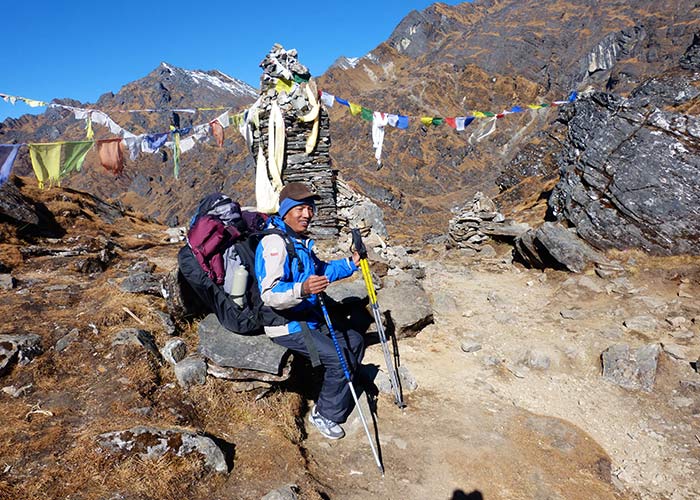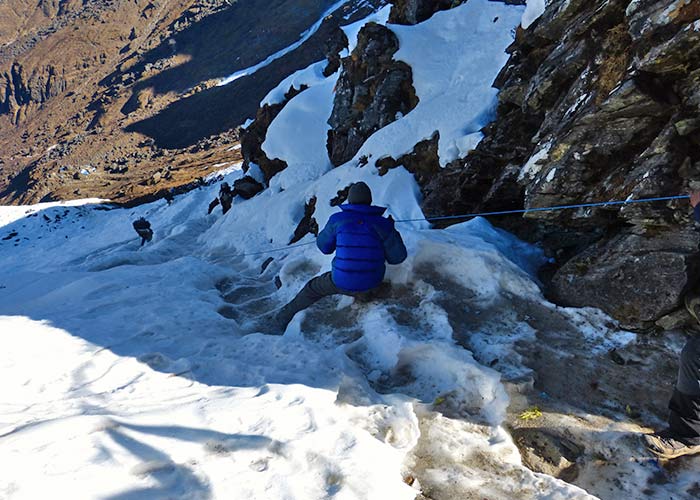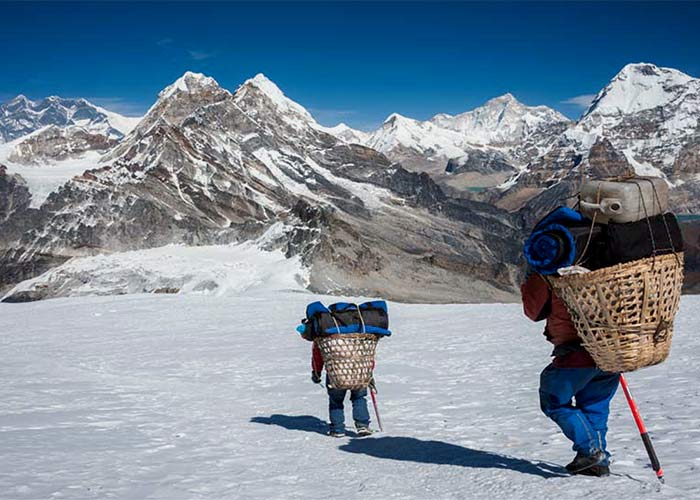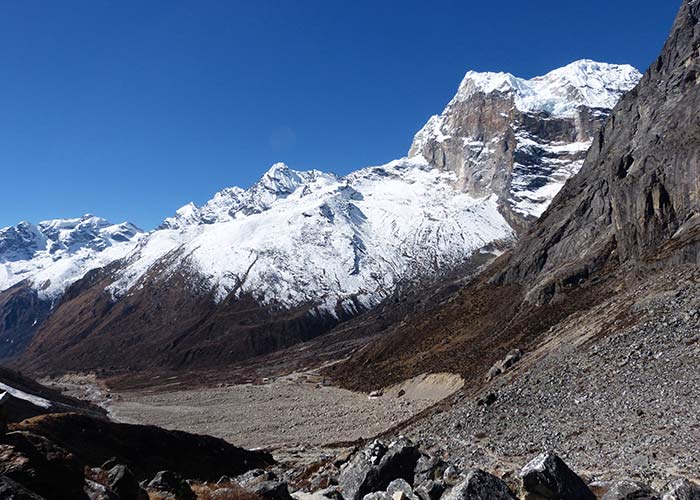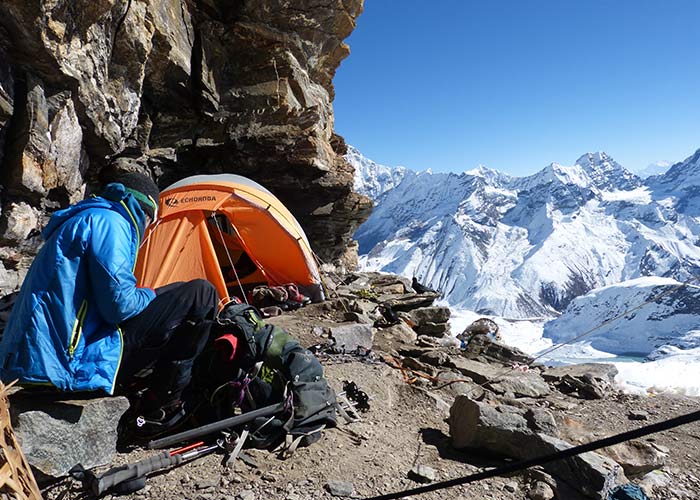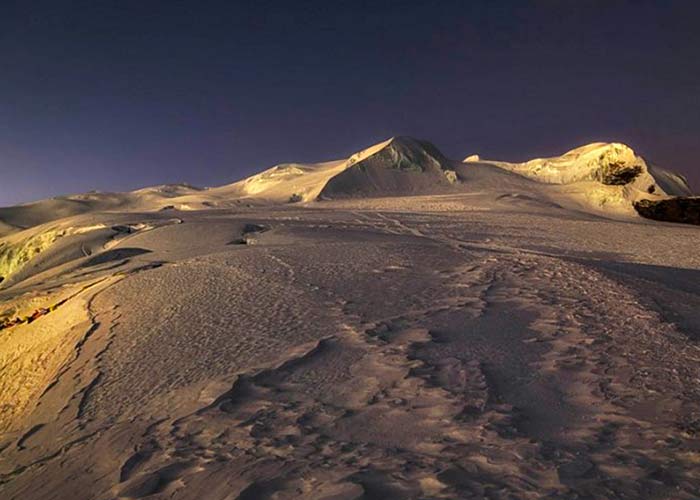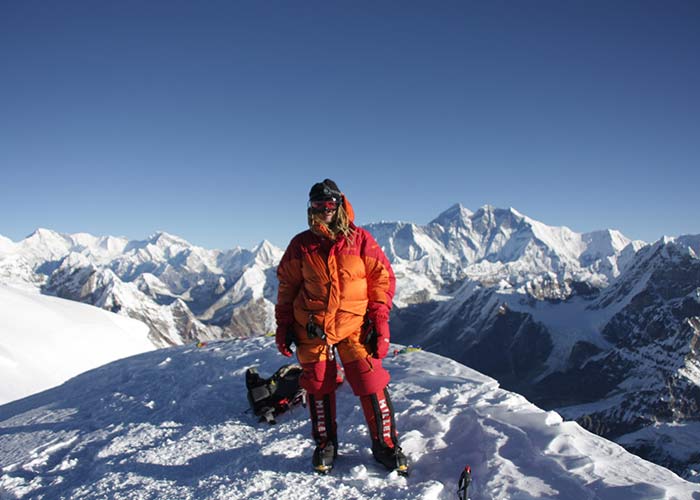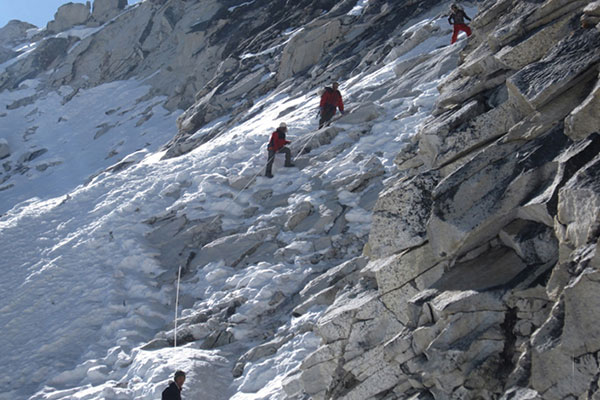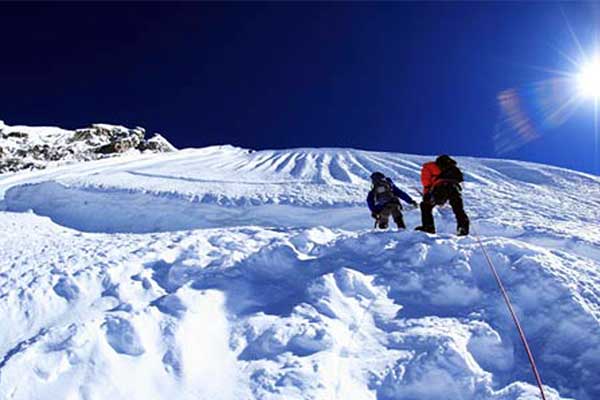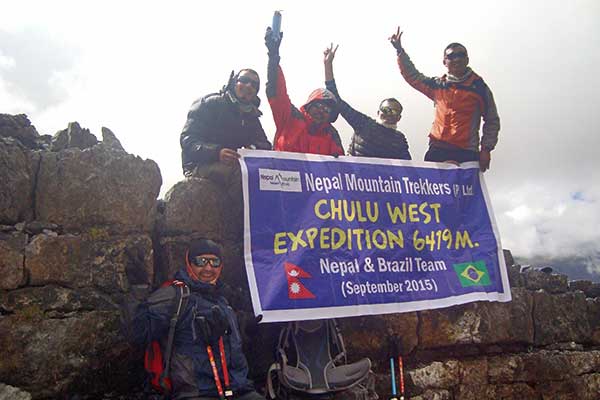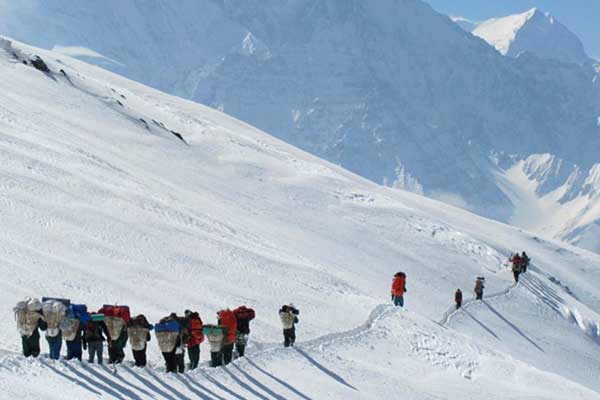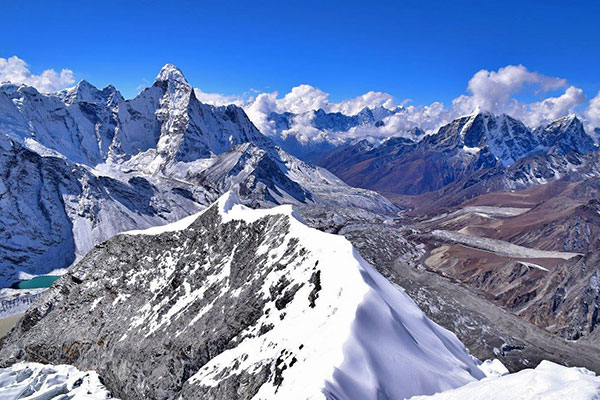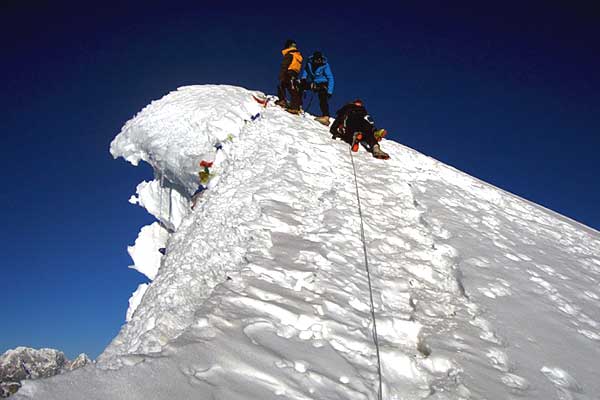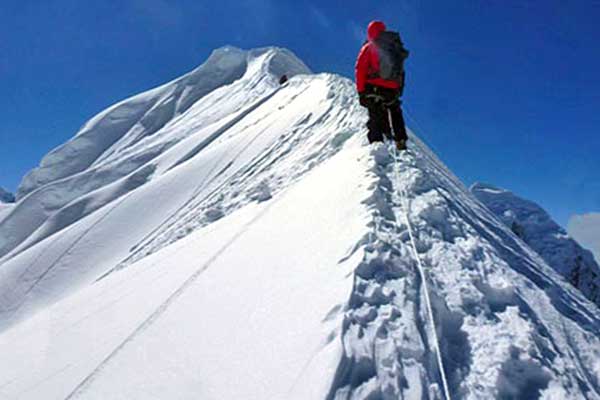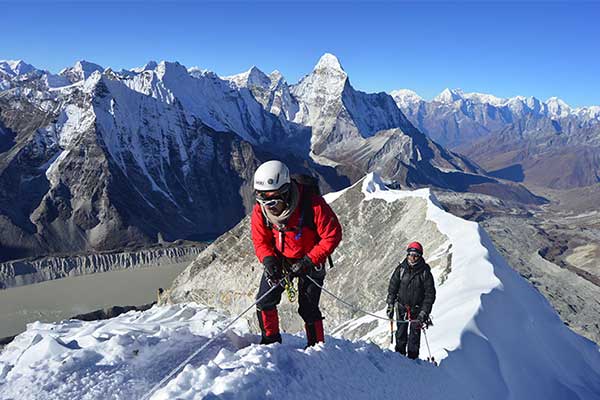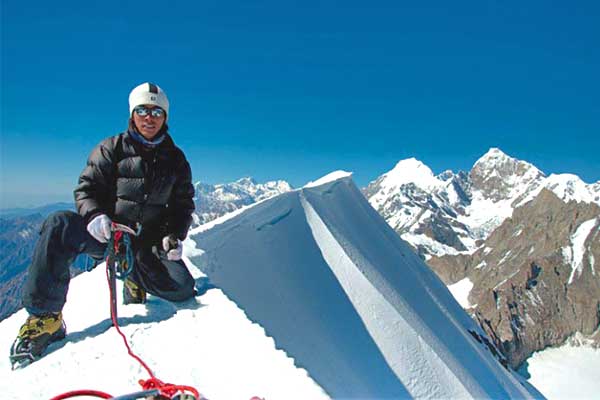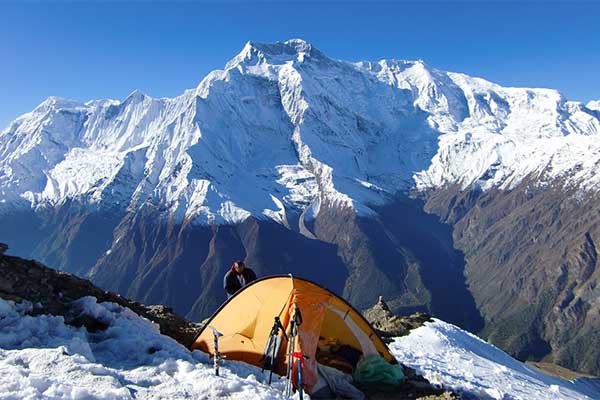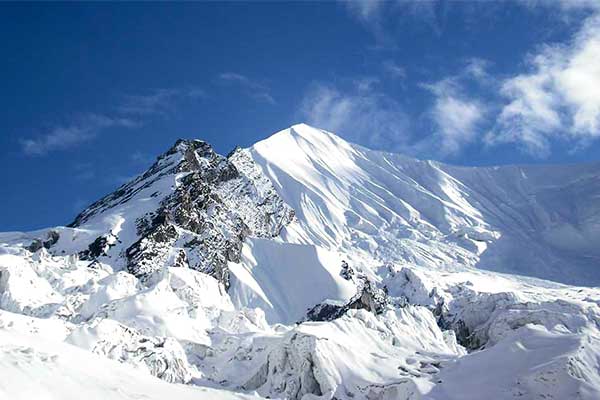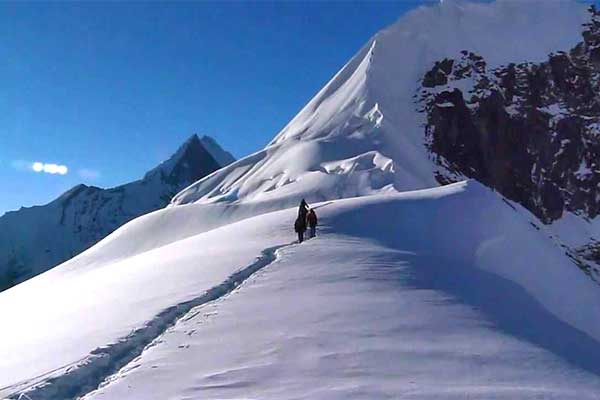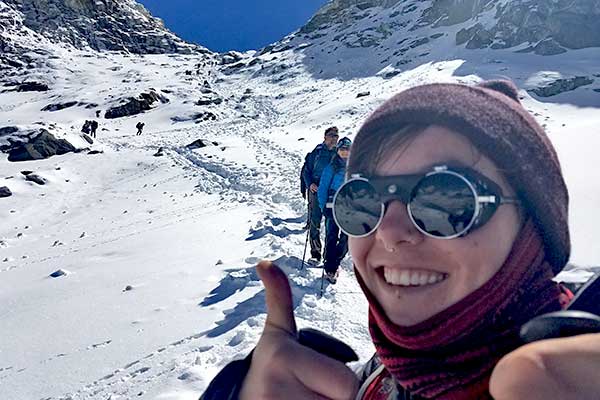Overview
Duration :
18 Days
Secondary Activity:
Nature and Glacier Walk
Max altitude :
6,461m/21,1907ft
Transportation:
Private Vehicle and Domestic Flight
Trip ends in:
Kathmandu
Accomodation:
Lodge and Tent Camp
Primary activity:
Trekking and Hiking
Group Size:
Min. 2 pax
Country:
Nepal
Trip starts from:
Kathmandu
Diffficulty:
Strenuous Plus
Meals:
Nepali and Continental
Best Season:
Autumn and Spring
Trip route:
Kathmandu-Lukla-Chutanga-Thuli Kharka-Kothe-Thaknak-Khare-Mera Base Camp-Mera High Camp-Khare-Kothe-Thuli Kharka- Lukla-Kathmandu
Trip introduction
“Climb the highest peaks and see the world from a different perspective.”
Mera Peak Climbing takes you on an adventurous trek to Mera Peak, one of the highest trekking peaks in Nepal. Mera Peak with an altitude of 6,476 m is situated in the Khumbu region of Nepal. It is well-liked by climbing enthusiasts. In principle, this peak is an exceptional initial peak for those without climbing knowledge. As you trek higher into this remote valley, following the river to the glaciers; you shall notice that this is a clear-cut climb for which acclimatization is the crucial component.
Overview of Mera Peak Climbing Itinerary
Our 18-day Mera Peak Climbing itinerary shall commence from Lukla, which is a short 30-minute wonderful flight from Kathmandu. The trekking route shall follow a direct path to Mera Peak. An expedition that’s famous for its miscellaneous experience to the climbers. Mera Peak climbing coalesces the contentment and gratification of mountain trekking.
One of the main highlights of our trek is the availability of rich Sherpa culture and heritage. Along with the discovery and sighting of the extravagant landscapes on the edge of the Khumbu region; rarely and seldom visited by other tourists. This is a teahouse trek with camping only during the climb. The forest ranges are occupied by alpine meadows and glacial rocks.
View from Mera Peak and other attractions
One of the main reasons people climb Mera Peak is for the magnificent summit views of the over-8000-meter-mountains such as Mt. Everest, 8848m, Mt. Lhotse, 8516m, Mt. Cho Oyu, 8201m, Mt. Makalu, 8463m, and Mt. Kanchenjunga, 8586m. You shall have a glimpse of authentic Sherpa culture, green and lush landscapes, and quaint trekking trails are other attractions.
This unblemished area of the Everest region is proud of having gorgeous terraced grasslands, impenetrable forests, hastening tributaries, and yak pastures with the surroundings of the utmost premier mountains on the planet. Here in this wilderness of the Himalayas, the Sherpa guesthouse provides a welcoming place for exhausted and worn-out trekkers.
After completing this epic trek a sense of achievement and self-joy shall reward trekkers with the utmost respect for the Himalayas. As our Mera Peak Climbing comes to a conclusion, we shall retrace our steps and gradually follow the trail back to Lukla for a flight back to Kathmandu.
Who can climb Mera Peak?
The trek gains high altitude fast with less time for acclimatization with an average 6-7 hours walk per day in hilly terrain. Preceding climbing understanding can be a benefit for this trek, but it is not obligatory. Because our exclusively trained guides shall help you commence and finish this trip entirely.
Best time to climb Mera
The most preferred point in time for Mera Peak Climbing is generally from March to May and September to December. So contact Nepal Mountain Trekkers now and join us on this adventurous peak climbing for a qualitative service. Simply fill out the booking form and let us know about your interest. Or you can contact us directly by sending us an email in order to get more information about this trek.
Special Note:
If this itinerary of Mera Peak Climbing doesn’t suit your requirement or if you want to customize it, please feel free to contact us. This trek could be customized as per your required time frame and budget limits.
Overview
-
Day 1Arrival in Kathmandu (1,350m/4,428ft):
-
Day 2Kathmandu (1300m/4264ft): Sightseeing and Preparation:
-
Day 3Fly to Lukla and explore around Lukla (2730m/8954ft):
-
Day 4Trek to Chutanga (3,430 m/11,250 ft): 3-4 hours:
-
Day 5Trek to Thuli Kharka (4320m/13200ft) via Zwatra la (4600 m/14720 ft): 5-6 hours:
-
Day 6Trek to Kothe (3600 m, /11808ft): 5-6 hours:
-
Day 7Kothe to Thaknak (4,350m/14,270ft): 3-4 hours:
-
Day 8Thaknak to Khare (5,045m/16,486ft): 2-3 hours:
-
Day 9Rest day in Khare/Acclimatisation::
-
Day 10Khare to Mera Base Camp (5300m/17,384ft): 3-4 hours:
-
Day 11Mera Base Camp to High camp (5,780m/18,958ft): 4-5 hours:
-
Day 12Mera High Camp to Summit (6,461m/21,1907ft) and back to Khare (5045m/16,547ft): 8-9 hours:
-
Day 13Reserve Day for Contingency:
-
Day 14Khare to Kothe (3600m/11808ft): 4-5 hours:
-
Day 15Kothe to Thuli Kharka: 5-6 hours:
-
Day 16Thuli Kharka to Lukla: 6-7 hours:
-
Day 17Lukla to Kathmandu:
-
Day 18Departure Day:
Detail Itinerary
Day 1 : Arrival in Kathmandu (1,350m/4,428ft)::
Welcome to the land of the Himalayas for experiencing one of the truly magical climbing experiences in Mera Peak. As you arrive in Kathmandu, the City of Temples, and complete the formalities at the customs, you shall be greeted by our representative who shall be there for the reception. You shall then be transferred to the hotel for your stay in a private vehicle by him/her. Get proper rest for the jetlagged body and in the afternoon you may stroll around the streets of Kathmandu to get refreshed. Prepare yourself for the sightseeing of the heritages of Kathmandu and its neighboring cities. Stay overnight in Kathmandu.
Day 2 : Kathmandu (1300m/4264ft): Sightseeing and Preparation::
Today we shall be exploring the medieval-aged heritages of the buzzing and lively Kathmandu city and another well-preserved city of Patan. Today you might want to see the ancient royal palaces in the heart of the old city with the ornate woodcarvings, the home of Kumari, revered as the living goddess, and several other temples and heritages. You may also pay a visit to the Swayambhunath Stupa, the 14th-century stupa also known as the Monkey Temple, which is famous for being the self-appearing stupa. Another heritage is the Boudhanath Stupa, one of the world’s largest stupas in the world, and the sacred Hindu pilgrimage of Pashupatinath Temple located at the bank of the holy Bagmati River. Later in the day, you shall have a full trek briefing by the climbing guide along with a gear check. Cash in the opportunity to clarify any queries regarding climbing to the highest trekking peak in Nepal. Pack your bags and get ready for the adventure beginning the next day. Overnight stay in Kathmandu.
Day 3 : Fly to Lukla and explore around Lukla (2730m/8954ft)::
The journey begins today. We shall take the route through Lukla for the climbing to Mera Peak. The flight to Lukla is a spectacular experience where you fly above the lush hills and valleys, the high Mahabharat hill range, torrential rivers that weave the valleys, and the view of the glittering and humongous Himalayas. Land in the Tenzing-Hillary Airport in Lukla, the gateway to the Khumbu or Everest region and the starting point of most of the trekking expeditions in the region, we shall today explore the richness and diversity of this beautiful village in the hills of eastern Nepal. Lukla, besides being the entry point to the Everest region, is also a full-sized and busy village catering to a large number of tourists and is known for its airport, often called one of the most dangerous airports in the world. We shall also explore the surrounding areas and enjoy the awesome mountainous views around this place, busy yet small market, Chortens, and monasteries, and interact with the locals to get an insight into the local culture and traditions. Stay overnight in Lukla.
Day 4 : Trek to Chutanga (3,430 m/11,250 ft): 3-4 hours::
With the hardworking porters who carry our gear and bags, friendly and experienced climbing Sherpas who shall assist in setting up tents and camps, and the Trekking guide, we shall leave for Chutanga. In an easy and introductory trek today, you shall take on the less traveled trail that takes us eastwards from Lukla. Wander through small hamlets and wood yards, the dense forest that hosts varieties of flora including pines, rhododendron trees, bushes, silver fir, and birch, and you shall reach the foothills of Nau Lekh or the Kalo Himal Ridge. Continuing along the trail that passes through several small streams, lush hillsides, and varieties of vegetation and summer pastures for the cattle before reaching the Chutanga, you shall be enjoying this introductory trekking in the Everest region. Stay overnight in Chutanga in a simple teahouse.
Day 5 : Trek to Thuli Kharka (4320m/13200ft) via Zwatra la (4600 m/14720 ft): 5-6 hours::
The level of strain shall increase a bit today as you shall cross a pass above 4000 meters of altitude. The trek today shall begin after we leave the lush village of Chutanga and have a short and steep climb to cross the Kalo Himal Ridge which is a part of the Nau Lekh range that separates the Khumbu Valley from the Hinku Valley in the region. The steep trekking continues as we shall be proceeding to a pass at 4500m marked with cairns and prayer flags before we head further to the higher Zwatra La Pass at 4600m trekking through a boulder slope and winding path. A pass that may accumulate substantial snowfall in the season, Zwatra La may be a bit difficult and confusing on a bad weather day. However, on a clear weather day, you can have a view of the extensive landscape of Hinku Valley, the mighty Dudh Koshi River, the impressive Lumding Himal, Karyolung Peak, and the rolling hills of the lower valley. Descend from this pass and you shall reach the settlement of Thuli Kharka after trekking for about an hour. Overnight stay in Thuli Kharka.
Day 6 : Trek to Kothe (3600 m, /11808ft): 5-6 hours::
In a wonderful trekking experience today you shall pass through three ridges, namely Hinku River, Hinku Valley, and Kothe. Beginning the trek, we shall have ups and downs from the settlement of Thuli Kharka as we leave the place with the view of sunrise over the high hills surrounding the village. You shall trek over the three rides mentioned earlier and reach the ridge top high above the Hinku River. From this hilltop, you may have a breathtaking view of the south side of Mera Peak if the weather is clear. Further on the trail get ready for a long and steep walk as you shall be descending through a long and narrow path through the dense forest adored by rhododendron trees, pine, and mosses. The trail leads us to the western side of the Hinku Valley. The trail then follows the Hinku River and through a forest with varieties of flora and fauna which shall lead you to Kohte, a settlement surrounded by high hills and guarded by huge boulders. Get rest during the overnight stay in Kothe.
Day 7 : Kothe to Thaknak (4,350m/14,270ft): 3-4 hours::
The trek today continues along the riverbed of the Hinku River and through the dense forest covered with rhododendron flowers mainly. Following the rocky riverbed, the remainder of the glacial lake outburst, and the trek continues upstream of the river. We reach the small village of Gondishung, a place for lunch for the trekkers and summer settlement, and thereafter to the Lungsumgba gompa, a 200-year-old Tibetan-styled monastery. Through the confluence of the Hinku and Sanu Drangka rivers and loose boulders, we carefully trek with the excellent views of the Kusum Kangaru and Peak 43 mountains to reach the Thaknak village after some trekking. Thaknak is a small village and a summer settlement with a few teashops and lodges. Overnight stay in Thaknak.
Day 8 : Thaknak to Khare (5,045m/16,486ft): 2-3 hours::
The destination for today is Khare, a small settlement we shall be using for acclimatization before we proceed for the Mera Peak climbing. Today we leave the village of Thaknak and follow the lateral moraine of Dig Glacier to reach the summer settlement of Dig Kharka. Here the trekkers can have the pleasure of witnessing the marvelous view of the Charpate Himal. We climb carefully through the lateral moraines and to the terminal face of the Hinku Nup and Shar glaciers. The climb further is steeper till we reach our destination for today, Khare. This place provides an amazing view of the northern face of Mera Peak, our ultimate destination. We shall be using this place as our base camp before we head for climbing Mera Peak. You may also opt for some light hiking around this place. Stay overnight in Khare.
Day 9 : Rest day in Khare/Acclimatisation:::
Today we shall separate our efforts for acclimatization as we shall be climbing as we head ahead from this place to the base camp and summit of Mera Peak. During our acclimatization, we shall be going for a day hike of a couple of hours to a glacier where we shall be practicing ice climbing as per the instruction of the leader of our expedition. Give your full attention to the instructions provided to you as these shall come in handy while you are climbing to the summit of Mera Peak. You shall have an idea of the use of an ice axe, climbing boots, crampons, harnesses, ascenders as well as the use of rope to go up and down. Learning these climbing techniques shall be useful to make your ascent to Mera Peak a successful one. After a few hours of practice, you shall return to the camp and prepare the equipment and pack your bags for the experience you are striving for the past several days. Stay overnight in a camp in Khare.
Day 10 : Khare to Mera Base Camp (5300m/17,384ft): 3-4 hours::
You shall be one step closer to your destination today as we shall be looking forward to reaching the Mera Peak Base Camp. There shall be short yet hard trekking to the base camp. On a trail marked with several boulders, big and small, the trail begins with a climb to the height of the moraine above Khare. Trekkers then have a slow and gradual ascent through a steep slope of snow to reach the bowl-like landscape. Trekkers then reach the Mera La Pass (5,415m) where the breathtaking views of Mera Peak and the surrounding areas can be seen. Descend little to find a suitable camping spot at the base camp on the side of Honku Himal. Trekkers may go for more practice if they feel that previous practice in Khare was not sufficient. Marvel at the spectacular sunset over the Honku Himal where the peak glows red due to the setting sun. Stay overnight in Mera Base Camp.
Day 11 : Mera Base Camp to High camp (5,780m/18,958ft): 4-5 hours::
Today we shall have a final preparation for tomorrow’s summit as we head further up the altitude to set up High Camp. The trek to the High Camp is a rather dangerous one as several crevasses have been reported after fresh snowfall in previous ascents, on this rocky trail. Even the trekkers not going for the climb to the peak can very well reach up to this place. From the High Camp, we have a stunning view of five of the world’s highest peaks including Makalu, Lhotse, Everest, Cho Oyu, and Kanchenjunga ranging from east to west. Marked by a large cairn, the High Camp provides a truly outstanding view of the sunset over the Himalayas though there is very limited camping available for the climbers. This may result in three people sharing a single tent. The glowing peaks of Makalu and other mountains are capable of taking your breath away. Prepare your equipment and clothes for the summit, for which we shall be moving very early from the High Camp. stay overnight in a tent in High Camp.
Day 12 : Mera High Camp to Summit (6,461m/21,1907ft) and back to Khare (5045m/16,547ft): 8-9 hours::
The ultimate destination of this trekking expedition arrives! With the target of conquering Mera Peak, we begin our ascent at least 3-4 hours prior to sunrise. After breakfast, the skilled members of the group fixed ropes and crampons, and the remaining members set out for the ascent. Continuing up the ridge and onto the ridge, we climb slowly armed with an ice axe and crampons avoiding the crevasses beneath us. Climbing speed becomes slow due to the altitude. In a non-technical ascent, as the dawn arrives, we have ourselves ascending steeply to the east of the left-hand ridge before moving to the right for making the summit easier. As the sherpas fix safety ropes to the bottom of the last part of the summit climb, we take a rest at the South Col and observe the marvelous sunrise over the Himalayas, the breathtaking scenery dominated by the white and lofty peaks, and prepare ourselves for the final push. We take on the steepest part of the climb in this last section with the help of jumar and keep avoiding the crevasses that change every year. Being on the top of the peak shall give you an extraordinary, jubilant, and triumphed feel. The magnificent view of Everest (8848m), Lhotse (8516m), Cho Oyu (8201m), Makalu (8463m), Kanchenjunga (8586m), Nuptse (7855m), Lobuche East (6145m), Chamlang (7319m) and other sibling peaks makes the climber forget every pain and strain overcome to reach to this point. Spending some time living your dream, you shall then leave the summit and head for Khare. Climbing down the summit is rather quick and easy as compared to the ascent, though this shall still be supported by the ropes fixed by the sherpas. After a long, strenuous, and highly rewarding day, we stay overnight in a tent in Khare.
Day 13 : Reserve Day for Contingency::
We have set this day aside for any contingency that may be occurring during our ascent to the Peak. This day is separated for cases where the ascent gets delayed when climbers take more than the estimated time to acclimatize, when the weather goes bad and when the ascent has to be delayed due to other contingent reasons. If the ascent is completed without delay, we can use this day for ice climbing or other activities.
Day 14 : Khare to Kothe (3600m/11808ft): 4-5 hours::
The trail used during our descent is the same as the route used for the ascent. Starting with the steep descent from Khare, we trek through the moraines of Dig glacier, settlements of Dig Kharka and Thaknak, fast-flowing rivers, traces of glacial outburst, rocky riverbed and twisting trail, summer settlements, and dense forest with varieties of vegetation and species of plants, views of the snow-capped and glittering mountains and the villages perched in the hillside with a unique lifestyle. Admiring the natural beauty and diversity of the region, we have our overnight stay in Kothe. Reaching Kothe, we shall be celebrating our successful climb with local delicacies and drinks. Overnight stay in Kothe.
Day 15 : Kothe to Thuli Kharka: 5-6 hours::
The trek along the Inkhu River continues today as we trek further to a lower altitude in the latter days of our trek in the Everest region. We trek past the ancient gompa with the map of Mardi Peak climbing encrypted on it, lush forests dominated by the rhododendron flower (the national flower of Nepal), small streams, and a couple of summer settlements before we reach Tashing Ongma which has tea shops in the season. We branch off the trail and walk through the viewpoint, a forest dotted with several vegetation, and lush hills and valleys. After reaching the settlement of Thuli Kharka, we take the desired rest and enjoy the view of the mountain of Mera North, Mera Central, and South Face, and the valleys leading up to the south side. Stay overnight in Thuli Kharka.
Day 16 : Thuli Kharka to Lukla: 6-7 hours::
This is the last section of where you shall be trekking before returning to Kathmandu. We start the trek by leaving the settlement of Thuli Kharka and reach the Zatrwa La Pass trekking past the prayer flags and cairns in an ascending walk. The top of this pass provides you with a view of Lukla valley and several lofty mountain peaks including the Cho Oyu, Kusum Khangru, Kongde Peak, and many others. With difficult terrain up in the past and the trail leading to a precarious height above the valley floor, the pass is a bit challenging for the trekkers who have been a part of long trekking. After the pass, trekkers descend all the way down to the Chutanga, and then in a straightforward walk, they reach the destination of Lukla. This marks the end of this trekking day and also the end of trekking in our expedition. We celebrate the successful trek in the region and climbing to the Mera Peak, with our fellow crew and team members with tasty local cuisines and drinks. We now prepare ourselves for the return to Kathmandu. Stay overnight in Lukla.
Day 17 : Lukla to Kathmandu::
Today we shall leave for Kathmandu. The flight to Kathmandu is generally scheduled in the morning to avoid the disturbances caused by afternoon wind in Lukla. Trekkers should be prepared for the delay or cancellation of flights due to the bad weather which is beyond our control. The flight takes you over the vast landscape of hills of Nepal with the view of the Himalayas, lush valleys, and other natural beauties. After you land in the domestic terminal of Tribhuvan International Airport, you shall be transferred to your hotel. Take proper rest and later in the day you may go for some afternoon shopping to take with you some souvenirs for your near and dear ones. You may also wander around in the streets of Thamel. Pack your bags for your return flight to the onward destination. Stay overnight in Kathmandu.
Day 18 : Departure Day::
The adventurous, exciting, and entertaining Mera Peak Climbing comes to an end today. You may engage in some other activities if you have booked with us or you may go for last-minute shopping. Extend your stay and enjoy other packages if you have enough time for staying in Nepal. You shall be transferred to the airport for your flight to your onward destination by a representative of Nepal Mountain Trekkers. We thank you for being a part of our team and we hope that you have created some of the best memories of your life during this trek. We hope that this nation full of contrasts, diversity, and mysticism has tempted you to another visit to this Himalayan nation called Nepal. Have a safe and happy journey ahead!
Price Includes
- Airport Pick-up and drop service (International and Domestic)
- 3 nights Hotel in Kathmandu(Hotel Green Horizon or similar standard)
- All accommodation during the trek in the best hotels/tea houses in the area (differing according to the price you wish to spend)
- Sanitation: The accommodation we provide will be neat and clean with warm hospitality and quality services.
- Single Accommodation: You won’t have to share your accommodation with anyone else so your privacy is protected.
- All foods during the trek: Breakfast, Lunch, and Dinner; any items on the menu as much as you wish to consume.
- We provide hygienic and safe meals to re-energize you.
- We request you not to waste your meals for it is difficult to transport food in the rural area.
- You are not allowed to share your meals with anyone else from another group.
- Domestic Flight(Kathmandu – Lukla – Kathmandu)
- Professional and Highly experienced English-speaking Trekking Guide licensed by the Government. Including their lodging and food.
- Local Staff: Our guides are locals of the region which ensures that you will surely get to explore a bit more during the trek than with any other guides.
- Experienced: With the experience of more than a decade of working in this field, our trekking guides possess excellent knowledge of briefing during the trek as well as they are experts in handling all kinds of critical situations that might occur during the trek.
- Insurance: Nepal Mountain Trekkers have an insurance policy for all our trekking staff.
- Porters (1 porter for 2 trekkers with a max load of 25 KG). Including their lodging and food.
- Local Staff: The porters we hire belong to the same region where we trek in order to provide employment opportunities to the locals as well as to make you explore every prospect of the region.
- Well-experienced Ice-Climbing Guide including Climbing Service Charge, Insurance, Food, Accommodation, and Personal Equipment.
- Group Climbing gear fixed rope, main rope, ice axe, zoomer, harness, the figure of eight, carabineer
- Four seasonal sleeping bags, down jacket, Nepal Mountain Trekkers duffer bag, t-shirt, and trekking map (Note: down jacket and sleeping bag are to be returned after trip completion)
- Peak Permit Royalty, Barunche National Parks, and Sagarmatha national park fee
- A comprehensive medical kit
- Rescue Arrangement Service
- 13% VAT and 10% company service charge
- Farewell Dinner
Price Excludes
- Nepalese visa fee (Visa Information)
- International airfare to and from Kathmandu
- Excess baggage charges
- Lunch and evening meals in Kathmandu
- Extra night accommodation(s)
- Travel Insurance and Rescue Cost
- Personal expenses (phone calls, laundry, bar bills, battery recharge, extra porters, bottle or boiled water, shower, etc.)
- Personal trekking and climbing gears
- Tips for guides and porters
Equipments
 Equipment List
Equipment List
- Duffel Bag
- Day Pack (35-45 L)
- Sleeping Bag (-20F/-30C recommended)
- Down Jacket
- Trekking Boots
- Crocs (evenings & washing)
- Trekking Pants (2-3)
- T-Shirts (3)
- Long-sleeve Trekking Shirts (2-3)
- Trekking Jacket
- Gortex (or similar) Jacket & Pants
- Fleece or Thermal Top (evenings)
- Fleece or Thermal Bottoms (evenings)
- Lightweight Long Underwear (to sleep in or layer under clothes)
- Socks (5)
- Gloves (lighter & heavier for passes)
- Wool Hat
- Baseball Cap or Wide-brimmed Hat
- Camp Towel
- Trekking Poles (optional, recommended)
- Down Booties (optional, recommended)
- Sunglasses (2)
- Water Bottles | Nalgenes (2-3)
- Bladder (optional, recommended)
- Toiletries, Sunscreen with SPF, Lip Balm with SPF
- Watch (with alarm)
- Extra Batteries
- Battery Chargers
- Head Lamp (2)
- Yak Trax (for treks with icy passes)
- Water Purifying Tablets, Small Water Filter or Steripen
- Camp Washing Bowl (optional, collapsible for clothes)
- Laundry Detergent (Kathmandu) or Bio-degradable Clothes Soap
- Hand Sanitizer
- Small Solar Panel (optional, recommended for iPods, iPhones, camera batteries, Kindles)
- Book(s)
- Zip-Lock | Plastic Bags
- Soft Toilet Paper | Tissues (we supply toilet paper but you will want something softer for blowing your nose)
- Baby-Wipes | Wet-Wipes (for personal cleaning)
- Handi-Wipes, J-Cloth, or Chux (optional: easy for a quick daytime clean, fast drying)
- Rehydration | Electrolytes
- Snacks!
- Personal Medical Supplies
- Available in Namche Bazaar
- Snacks, chocolate bars, energy bars (Western brands), dried fruit & nuts
- Laundry Detergent
- ALL trekking gear (Sherpa Gear, Mountain Hardwear, Tsetang’s Gear Shop all have real gear), real & knock-offs.
- Lemon Tang (for water if you want)
- Batteries
- Trekking Poles
- Micro Spikes
- Medical Supplies
- We strongly suggest bringing Western meds with you as there are a lot of Indian fakes on the market!
- Suggested: Diamox, Azithromycin, Ciprofloxacin, Tinidazole, or Flagyl & Augmentin. Bring COMPEED for covering blisters & good tasting electrolytes &/or rehydration salts (Emergen-C is a good American brand). The local versions aren’t very appealing.
- We also recommend bringing strong knee & ankle supports & braces, ACE bandages for sprains & strains, Tegaderm &/or other would coverings. Duct tape is always useful. We’re happy to take excess medical supplies off your hands when you leave if you won’t need them and pass them on to others. We use lots of the large amount we have with us to treat locals we meet when trekking.
Related Trips
You will also like …
